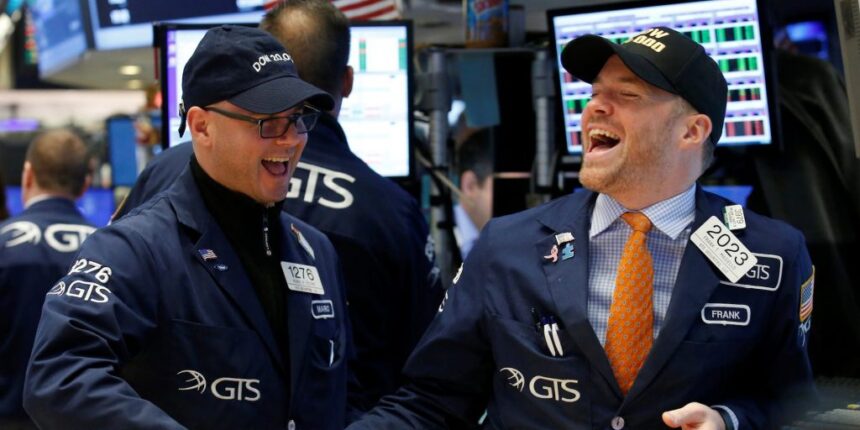The year 2025 has kicked off with a resounding victory for bullish investors, leaving short sellers reeling from massive losses. According to data from S3 Partners, traders betting against stocks in the U.S. and Canadian markets have collectively lost a staggering $73 billion in the first weeks of the year. This dramatic downturn for short sellers comes amid a robust market rally that has caught many off guard.
“The rally in the market was not kind to short sellers,” remarked Ihor Dusaniwsky, head of predictive analytics at S3 Partners, in an interview with Yahoo Finance.
The S&P 500 (^GSPC) has climbed approximately 4% year-to-date, but the gains have been even more pronounced for individual companies. Many of these surges have been fueled by short squeezes, a phenomenon where stocks rise sharply, forcing bearish traders to buy back shares to cover their positions. This buying activity, in turn, drives prices even higher, creating a feedback loop that can devastate short sellers.
Super Micro Computer Leads the Charge
One of the most notable examples of this trend is Super Micro Computer (SMCI), the S&P 500’s top performer this year. The stock has skyrocketed over 110% since the start of 2025, leaving short sellers with losses exceeding $2.2 billion.
Super Micro Computer’s meteoric rise has been accompanied by a “squeeze score” of 100, according to S3 Partners’ proprietary model. This score, which measures a stock’s susceptibility to short squeezes, ranges from 0 to 100, with readings above 70 indicating high vulnerability. A score of 100 suggests the stock is “extremely susceptible” to a squeeze, and SMCI’s performance has proven this metric accurate.
The Anatomy of a Short Squeeze
Short squeezes occur when a large number of investors bet against a stock, only to see its price rise instead. As the stock climbs, short sellers are forced to buy shares to close their positions, further driving up the price. This dynamic was famously at play during the 2021 meme stock frenzy, when companies like GameStop saw their shares surge over 134% in a single day.
“Short sellers are guaranteed future buyers,” explained JC Parets, chief market strategist at All Star Charts, in a recent note. “When shorts are getting squeezed, these can become forced liquidations.”
This year has seen no shortage of such forced liquidations. Beyond Super Micro Computer, several other stocks have experienced dramatic rallies due to short squeezes.
Hims & Hers Health, Oklo, and BigBear.ai Join the Rally
Hims & Hers Health (HIMS), a health and wellness platform, has also been a standout performer. The company announced plans to introduce at-home lab testing through its platform, sending its stock soaring 22% in a single day. Year-to-date, HIMS has rallied over 80%, and short sellers have lost nearly $2 billion betting against it. Like SMCI, HIMS boasts a squeeze score of 100.
Meanwhile, Oklo (OKLO), a nuclear energy company with a focus on artificial intelligence, and BigBear.ai (BBAI), a leader in AI-driven decision-making software, have also seen significant gains. Both stocks have squeeze scores above 70, indicating their susceptibility to short squeezes. Year-to-date, Oklo and BigBear.ai have surged over 80%, further compounding losses for short sellers.
A Broader Market Trend
The pain for short sellers is not confined to a handful of stocks. As the market rally broadens, more sectors and regions are participating, creating a challenging environment for bearish traders.
“As more stocks, more sectors, and more countries around the world start to participate in this bull market, any of the short sellers who overstayed their welcome are getting blown up,” Parets noted. “This is a classic characteristic of healthy bull market environments.”
Looking Ahead
The start of 2025 has been a stark reminder of the risks associated with short selling. While bearish bets can yield significant profits in declining markets, they can also lead to catastrophic losses during rallies. As the bull market continues to gain momentum, short sellers may need to reassess their strategies to avoid further damage.
For now, the bulls are firmly in control, and the $73 billion loss for short sellers serves as a testament to the power of market optimism. Whether this trend will persist remains to be seen, but one thing is clear: 2025 is shaping up to be a year where the bears are on the defensive.
Disclaimer: This article is for informational purposes only and does not constitute financial advice. Investors should conduct their own research or consult a financial advisor before making investment decisions.
